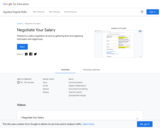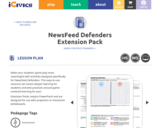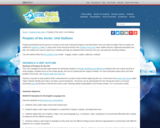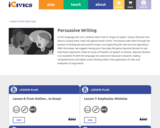
This tutorial uses text and audio to introduce narrative writing. [2:03]
- Subject:
- Arts
- English Language Arts
- Material Type:
- Audio/Video
- Provider:
- Sophia Learning
- Date Added:
- 12/01/2023

This tutorial uses text and audio to introduce narrative writing. [2:03]

If you are involved in any way with a school newspaper, yearbook or other school publication, you should be familiar with the national Scholastic Press Association. Teachers or students with an interest in design, article ideas, or legal issues can find a solid base of information here. Some material is free while other material requires membership for access.

Prepare for a salary negotiation at work by gathering facts and organizing information with digital tools. Time to complete: 45-90 minutes

Provides some good, practical advice on writing poems. Written in a simple, down-to-earth style that is easily accessable. An outline at the top of the page will lead you to different sections of the page. Part of a larger poetry publishing site navigable from the left side of the page.

Make your students' game play more meaningful with activities designed specifically for NewsFeed Defenders. This easy-to-use resource set means deeper learning for students and best practices around game-centered learning for you!
Extension Packs require PowerPoint and are designed for use with projectors or interactive whiteboards. LESSON OBJECTIVES: Identify markers of verification, transparency, accountability, and independence in news stories. *Define and identify problematic news items, and other news-related types of misinformation. *Explain a variety of strategies to verify images and information *Evaluate text for bias based on word choices and framing methods. *Use third party information to judge credibility of a source. *Evaluate the benefits and challenges of digital news and social media to a democratic society.

This is a fabulous site for learning all about writing news for the radio. Lots of links and great tips!

An article describing what lower-literacy is and the characteristics and differences between them and higher-literacy users. There is also a section on improving usability for lower-literacy users especially pertaining to the internet.

This site focuses on the 6+1 TraitTM Writing framework.

An excellent interactive site which allows students to take notes as well as organize, plan, and revise their writing, as well as assist with reading skills. Provides several options for student creativity and improvement concerning notetaking skills.

Contains plans for five lessons that teach about fairy tales and literary elements by having students write their own fractured fairy tales. In addition to objectives and standards, this instructional plan contains links to sites used in the lessons as well as assessment and reflection activities.

This multimedia site offers readings of Whitman's poetry, an introduction, a gallery of images and works through the years of his career, and a reflection of Whitman's significance.

Students are asked to explain how natural disasters affect environmental health.

Compilation of various English poems. The poems are classified chronologically, alphabetically (by author), by title, and by first lines.

This is a collection of 24 printable activities sheets for grades Pre-K to grade 2.
![PBS Kids: Super Why: Letters in Your Name Worksheet [PDF]](https://openspace.infohio.org/static/newdesign/images/materials/default-thumbnail-index.png)
An excellent resource for students learning to spell their names. The student must circle the letters in their name and then write their name in the space provided.

In this lesson, students explore the many characteristics of a newspaper and try their hands at becoming reporters. They can expand their knowledge about Ernest Hemingway, and author a newspaper focusing on his life, especially his interests and travels. While this lesson is designed in conjunction with the PBS program, "Hemingway Adventure," access to the program is not essential to the lesson.

What are advertisers really selling? Are there hidden messages in ads? In this lesson, students explore the concept of persuasive advertising and evaluate ads directed at young consumers. A timely lesson that would generate interesting debate for intermediate and middle school students. Links available to other PBS activities and lesson plans.

This online writing assistance offers help in the writing process, grammar and mechanics, usage, and four different types of essays, as well as help on deciding what and how to document.

This article assembles free resources from the Peoples of the Arctic issue of the Beyond Penguins and Polar Bears cyberzine into a unit outline based on the 5E learning cycle framework. Outlines are provided for Grades K-2 and 3-5.

This is a full unit of study from iCivics, featuring multiple lesson plans with presentations, downloadable documents, and more. In this language arts unit, students learn how to "argue on paper" using a fictional case about a school dress code rule against band t-shirts. The lessons take them through the process of writing two persuasive essays: one supporting the rule and one opposing it. After the essays, we suggest having your class play the game Supreme Decision to see how these arguments relate to issues of freedom of speech in schools. Supreme Decision is an excellent fit with the language arts classroom because it requires reading comprehension and higher-order thinking skills in the application of rules and evaluation of arguments.